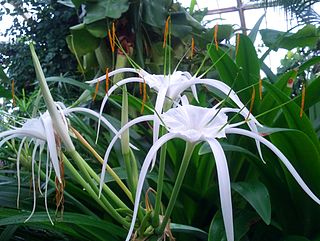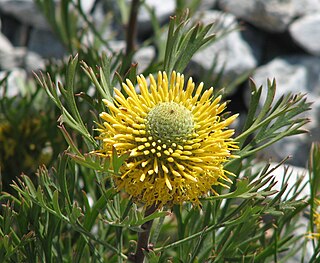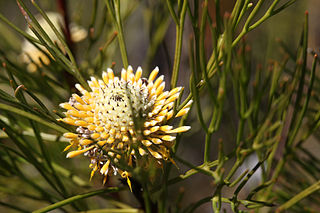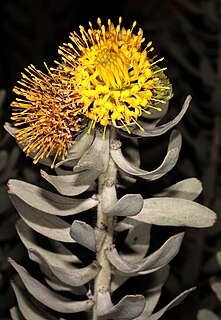
Calypso is a genus of orchids containing one species, Calypso bulbosa, known as the calypso orchid, fairy slipper or Venus's slipper. It is a perennial member of the orchid family found in undisturbed northern and montane forests. It has a small pink, purple, pinkish-purple, or red flower accented with a white lip, darker purple spottings, and yellow beard. The genus Calypso takes its name from the Greek signifying concealment, as they tend to favor sheltered areas on conifer forest floors. The specific epithet, bulbosa, refers to the bulb-like corms.

Richard Anthony Salisbury, FRS was a British botanist. While he carried out valuable work in horticultural and botanical sciences, several bitter disputes caused him to be ostracised by his contemporaries.

Hymenocallis (US) or (UK) is a genus of American plants in the amaryllis family.

Banksia speciosa, commonly known as the showy banksia, is a species of large shrub or small tree in the family Proteaceae. It is found on the south coast of Western Australia between Hopetoun (33°57′ S) and the Great Australian Bight, growing on white or grey sand in shrubland. Reaching up to 8 m (26 ft) in height, it is a single-stemmed plant that has thin leaves with prominent triangular "teeth" along each margin, which are 20–45 cm (7.9–17.7 in) long and 2–4 cm (0.8–1.6 in) wide. The prominent cream-yellow flower spikes known as inflorescences appear throughout the year. As they age they develop up to 20 follicles each that store seeds until opened by fire. Though widely occurring, the species is highly sensitive to dieback and large populations of plants have succumbed to the disease.

Isopogon anemonifolius, commonly known as broad-leaved drumsticks, is a shrub of the family Proteaceae that is native only to eastern New South Wales in Australia. It occurs naturally in woodland, open forest, and heathland on sandstone soils. I. anemonifolius usually ranges between one and two metres in height, and is generally smaller in exposed heathland. Its leaves are divided and narrow, though broader than those of the related Isopogon anethifolius, and have a purplish tinge during the cooler months. The yellow flowers appear during late spring or early summer and are displayed prominently. They are followed by round grey cones, which give the plant its common name drumsticks. The small hairy seeds are found in the old flower parts.

Isopogon anethifolius, commonly known as narrow-leaf drumsticks or narrow-leafed drumsticks, is a shrub in the family Proteaceae. The species is found only in coastal areas near Sydney in New South Wales, and to the immediate west. It occurs naturally in woodland, open forest and heathland on sandstone soils. An upright shrub, it can reach to 3 m (10 ft) in height, with terete leaves that are divided and narrow. The yellow flowers appear from September to December and are prominently displayed. They are followed by round grey cones, which give the plant its common name of drumsticks. The small hairy seeds are found in the old flower parts.

Dendrobium speciosum, commonly known as the rock orchid or cane orchid, is a species of highly variable Australian orchid. Its varieties can be found in a range of habitats as epiphytes or lithophytes. It has a continuous distribution along the east coast of Australia and in distinct populations along the Tropic of Capricorn. As a lithophyte, it forms gigantic spreading colonies on rocks and cliff faces, often exposed to full sun, with its roots forming dense, matted beds across the rock that anchor the plant. It can be found at altitudes from sea level to 900 metres (3,000 ft).

Hymenocallis littoralis or the beach spider lily is a plant species of the genus Hymenocallis, native to warmer coastal regions of Latin America and widely cultivated and naturalized in many tropical countries.

Colchicum speciosum is a species of flowering plant in the family Colchicaceae, native to mountainous areas of northern Turkey, the Caucasus and northern Iran. Growing to 18 cm (7 in) tall by 10 cm (4 in) wide, it is an herbaceous perennial growing from corms. C. speciosum blooms in the fall, producing reddish/violet flowers on stems up to 30 centimetres (12 in) tall without any leaves present. The strap-like leaves grow in the spring, then yellow, wither and die back as summer progresses. The flowers strongly resemble those of the crocus, the familiar spring-flowering bulb; hence the common name autumn crocus which is applied to this and other colchicum species. However the two genera belong to different families; and there is in fact an autumn-flowering crocus species, Crocus sativus, the source of the spice saffron. By contrast, all parts of Colchicum speciosum are toxic if ingested.

Leucospermum hypophyllocarpodendron is a creeping, mat-forming shrub with heads of yellow flowers and leathery, upright narrow leaves with some red-tipped teeth at their tips, from the family Proteaceae. It has long thin branches that originate from an underground rootstock and grows on poor, sandy soils in southwestern South Africa. The rose-scented flower heads can be found for August to January and are visited by different monkey beetles, bees and flies. It has two subspecies, one with greyish leaves U-shaped in cross section called grey snakestem pincushion in English and gruisslangbossie in Afrikaans, the other with green leaves that are flat in cross-section called green snakestem pincushion and groenslangbossie.

Hymenocallis caribaea is a plant in the Amaryllidaceae with the common names "Caribbean spider-lily" or "variegated spider-lily." It is native to the islands of the Caribbean and to northern South America. It is regarded as native to Puerto Rico, Jamaica, Hispaniola, Cuba, the Virgin Islands, and the Windward and Leeward Islands, and the Venezuelan Antilles. It is also commonly cultivated as an ornamental in many other tropical and subtropical regions and reportedly naturalized in Sri Lanka, New South Wales, Bermuda, French Guinea, Suriname, and Guyana.
Hymenocallis tridentata, the Florida spider-lily, is a bulb-forming herb native to southern Florida, to about as far north as Vero Beach. The species grows in marshes and wet prairies very close to sea level. It is similar to H. rotata, but somewhat smaller.

Hymenocallis tubiflora is a plant species from Trinidad and northern South America. It is reported from Trinidad, Venezuela, Guyana, Suriname, French Guiana, and northern Brazil. The name was originally coined in 1812, the description based on a specimen grown at Kew Botanical Garden in London, the bulb having been seized by British sailors from a French ship captured by the Royal Navy in 1803.

Leucospermum oleifolium is an erect shrub of about 1 m (3.3 ft) high and 1½ m (5 ft) across that is assigned to the family Proteaceae. It has spreading branches, densely set with initially felty, entire, oval, olive-colored leaves of about 3½ cm long and 1½ cm (0.6 in) wide, with a bony tip that sometimes has two to five blunt teeth, with a blunt base and conspicuous veins. The flowers and their long thread-like styles are initially sulfur yellow, but soon become orange and finally turn brilliant crimson. The flower heads are about 4 cm (1.6 in) in diameter, crowded at the tip of the branches with a maximum of five that start flowering in turn. This provides for a colour spectacle from August till December. It is called by various names in South Africa such as Overberg pincushion, flame pincushion, mix pincushion and tuft pincushion. It naturally occurs in fynbos in the Western Cape province of South Africa.

Leucospermum calligerum is a softly hairy shrub, with wand-like branches, entire ovate leaves that have a bony tip of about 25 × 6 mm, and globular heads of 2–3½ cm (0.8–1.4 in) in diameter, with two to six together near the tip of the branches and flowering in turn, that consist of 4-merous flowers, initially cream-colored, later pink, with the petals curled and the styles 2–2½ cm (0.8–1.0 in) long, sticking out like pins from a cushion. It is called arid pincushion or common louse pincushion in English and rooiluisie in Afrikaans. Well-scented flowers can be found from July to January. It naturally occurs in fynbos in the Northern Cape and Western Cape provinces of South Africa.

Leucospermum tomentosum is an evergreen, mostly spreading shrublet of approximately 75 cm (3 ft) high and up to 3 m (10 ft) in diameter, with alternately set, linear or narrowly spade-shaped, grey felty leaves, with one to three teeth near the tip. It has round, seated flower heads of 3–3½ cm (1.2–1.4 in) in diameter, occurring in groups of one to four, and consisting of deep yellow, very sweet scented flowers. It can survive the occasional wildfire because it regenerates from the underground rootstock. It is an endemic species that is restricted to a narrow strip along the Atlantic coast of the Western Cape province of South Africa. The species flowers between June and November. It is called Saldanha pincushion in English.

Leucospermum rodolentum is an upright, evergreen shrub of up to 3.0 m high, from the family Proteaceae. It has felty grey, elliptic to wedge-shaped leaves of 4–6½ cm (1.8–2.6 in) long and ¾–1½ cm wide, and very sweetly scented, globe-shaped, 3–3½ cm (1.2–1.4 in) wide, bright yellow flower heads, that are seated or on a very short stalk of ½ cm long, grouped with two to four together. Its common names include is sandveld pincushion in English and sandluisie or sandveldluisiesbos in Afrikaans. The plants are in bloom between August and November. It is an endemic species that only grows in a small area of the Western Cape province of South-Africa.

Leucospermum saxatile is an evergreen, rising to sprawling shrub of ½–¾ m high and 1–1½ m (3⅓–5 ft) wide, from the family Proteaceae. It has reddish tinged flowering stems and line-shaped, narrowing wedge-shaped leaves of 2½–5 cm(1–2 in) long and 2–5 mm (0.08–0.20 in) wide, with one to three blunt teeth, whorl-shaped, flat-topped, at first pale lime green but later carmine flower heads of 2½–3 cm across, mostly individually but sometimes grouped with two or three, each on a stalk. The flower heads occur from July to October. From the flowers occur long styles with a slightly thicker tip, which together give the impression of a pincushion. It is called Karoo pincushion in English. Flowering heads can be found from July until February. It naturally occurs in fynbos in the Western Cape province of South Africa.

Protea canaliculata, also known as the groove-leaf sugarbush, is a species of flowering shrub of the genus Protea, which is endemic to the Cape Provinces of South Africa.

Protea caespitosa, also known as hottentot bishop sugarbush or bishop sugarbush, is a flowering shrub belonging to the genus Protea which is only found growing in the wild in South Africa.



















